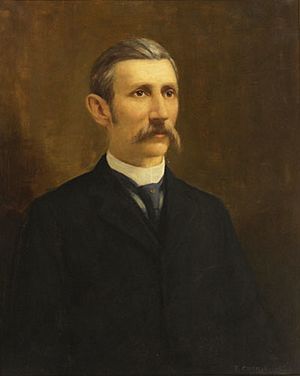Francis P. Fleming facts for kids
Quick facts for kids
Francis Philip Fleming
|
|
|---|---|
 |
|
| 15th Governor of Florida | |
| In office January 8, 1889 – January 3, 1893 |
|
| Preceded by | Edward A. Perry |
| Succeeded by | Henry L. Mitchell |
| Personal details | |
| Born | September 28, 1841 Panama Park, Florida (now Jacksonville) |
| Died | December 20, 1908 (aged 67) Jacksonville, Florida |
| Political party | Democratic |
| Spouse | Floride Lydia Pearson |
| Signature | |
| Military service | |
| Allegiance | |
| Branch/service | Confederate States Army |
| Years of service | 1861–1865 |
| Rank | Captain |
| Unit | 2nd Florida Infantry |
| Battles/wars | American Civil War |
Francis Philip Fleming (born September 28, 1841 – died December 20, 1908) was an American politician. He served as the 15th Governor of Florida from 1889 to 1893. Fleming was a member of the Democratic Party. Before becoming governor, he was a soldier for the Confederacy and a lawyer. During his time, he held views and supported policies that led to racial segregation, which are now widely recognized as harmful and unfair.
Contents
Early Life and Military Service
Francis Philip Fleming was born in Panama Park, Florida. This area is now part of Jacksonville. He grew up on his family's plantation called "Hibernia." It was located along the St. Johns River.
During the American Civil War, Fleming joined the Confederate army. He started as a private in the 2nd Florida Regiment. He bravely earned promotions on the battlefield. He became a first lieutenant and later a captain.
After being wounded, Fleming returned to Florida. He helped recruit new soldiers. He even led a group of volunteers at the Battle of Natural Bridge. This battle happened near St. Marks on March 6, 1865. By the end of the war, he had served under several important generals.
Life After the War
After the Civil War ended, Francis Fleming decided to study law. He became a lawyer in 1868. He worked with different law firms.
In 1871, he married Floride Lydia Pearson. Her father was a judge on the Florida Supreme Court. Francis and Floride had three children together. Their names were Francis Philip Jr., Elizabeth, and Charles Seton.
Fleming also wrote a book about his brother. It was called The Florida Troops/A Memoir of Captain C. Seton Fleming C.S.A.. He wrote it to remember his brother's life and service as a soldier.
Becoming Governor of Florida
Francis P. Fleming later entered the world of politics. He became the 15th Governor of Florida on January 8, 1889. He served one term until January 3, 1893. At that time, state law allowed governors to serve only one term.
During his time as governor, several important things happened:
- A state Board of Health was created. This was done to help stop a yellow fever epidemic (a widespread disease) in Florida.
- The Florida Railroad Commission was ended. This happened because a powerful railroad owner, Henry Flagler, wanted it removed.
- Work began to reorganize Florida's higher education institutions. This means they started to improve colleges and universities.
- Changes were made to how the state collected money (revenues).
- The Farmers' Alliance movement was active. This was a group that supported farmers.
- There was a dispute over the reelection of Senator Wilkinson Call in 1891.
Fleming also suggested adding a red diagonal cross, called a saltire, to the Florida flag. He wanted to make sure the flag looked different from a white flag of surrender. This idea was approved by voters in 1900. He also started the tradition of having an official portrait painted for the Florida State Capitol.
Later Life and Legacy
After leaving office, Fleming continued to serve the state. He was on the board of trustees for the new Florida Old Confederate Soldiers and Sailors Home. This home helped former soldiers.
Francis Philip Fleming passed away on December 20, 1908, after a long illness. He was buried in the Old City Cemetery in Jacksonville.
Interesting Facts
- Francis P. Fleming's parents were Lewis Fleming and Margaret Seton.
- Fleming Island, Florida is a community in Clay County, Florida. This area was once part of the Fleming family's land grants from Spain. The name "Fleming Island" has stayed with the area ever since.
- Both Governor Fleming and his wife, Floride, are buried in The Old City Cemetery in Jacksonville, Florida.
- The original football field at the University of Florida (UF) was renamed "Fleming Field" in 1915. This was done at the request of his son, Francis P. Fleming Jr. The field was later replaced by a larger stadium, but the grassy area nearby is still known as Fleming Field.

